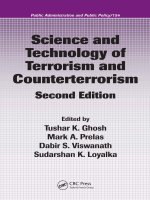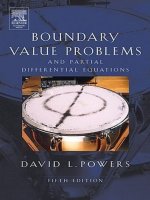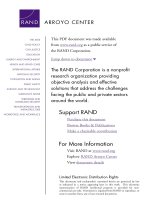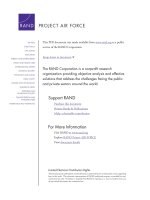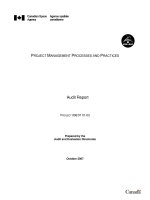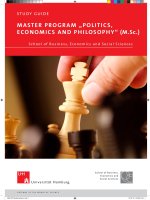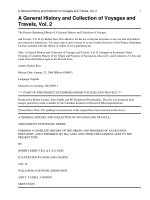MANAGEMENT PROCESS AND ORGANISATIONAL BEHAVIOUR OBJECTIVES pptx
Bạn đang xem bản rút gọn của tài liệu. Xem và tải ngay bản đầy đủ của tài liệu tại đây (491.13 KB, 41 trang )
Master of Business Administration Ist Semester
101: MANAGEMENT PROCESS AND ORGANISATIONA L BEHAVIOUR
OBJECTIVES
The purpose of this course is help the students to understand management functions, to
familiarize themselves with the practice of management, to develop an understanding of
behavioural process of the organizations as a whole, and to cultivate an insight into the
individual behaviour at work place.
UNIT-I
Meaning, Nature and Scope of Management; Emergence of Management Thought –
Classical, Neo-Classical and Modern Theories; Roles, Skills and Responsibilities of
Managers; Universality of Management Principles; Functions of Management;
Comparative Management – Japanese, American and Indian.
UNIT-II
Planning and Decision Making – Process, Premises, Types of Plans; Decision – Making –
Process, Types of Decisions, Creativity in Decision Making, Techniques; Control –
Process and Techniques.
UNIT-III
Organizations – Meaning, Principles, Types of Organizations; Organizational Behaviour
– Meaning and Scope; Models of OB; Contributing Disciplines to OB: Emerging
Challenges for OB: Organizations as Social Systems.
UNIT-IV
Foundations of Individual Behaviour; Individual Differences; Basic understanding of
Attitudes, perception, Personality, and Learning; Work Motivation – Theories and
Applications; communication – Process, Forms, Barriers and Effectiveness.
UNIT-V
Group Dynamics – Overview of Groups, Types, Stages, Group Decision – making;
Interpersonal Relationship; Inter – group Dynamics – Interactions, Influencing Factors;
Leadership Concept, Theories, and Effectiveness.
SUGGESTED READINGS;
1. Koontz, H. and Welrich, H; Management, Mc Graw Hill, 1995
2. Luthans, F. Organizational Behaviour, McGraw Hill, 1995
3. Robbins, Stephen P, Management, Englewood Cliffs, Prentice Hall Inc, 1996
4. Robbins, Stephen P, Organizational Behaviour; Sultan Chand & Sons, New Delhi,
202.
5. Gregory Moorhead and Ricky W Griffin; Organizational Behaviour – Managing
People and Organizations, Jaico Pub. Ouse, Bombay, 200
6. Stoner, J. et. Al. Management, New Delhi, Prentice Hall of India, 200
7. Prasad, LM; Organizational Behaviour; Sultan Chand & Sons, New Delhi, 202
The list of cases and specific references including recent articles will be announced in the
class at the time of launching of the course.
Master of Business Administration Ist Semester
102: MANAGEMENT SCIENCE-I.
OBJECTIVE;
The Objective of course is to make the students familiar with some basic quantitative
techniques. The main focus however is in their application in business decision-making.
Unit-I:
Management Science: Executive problems, Scope for quantification, Translating
Business problems into mathematics, Concept of Limits, Rate of change – derivatives and
finite difference (simple problems) First Differential of a monomial. x+y, x, x y types.
Concept of Maxima and Minima.
Unit-II:
Graphical and Tabular representation: Concept of a function, Role of functional analysis
in business, inequalities and their representation on graphs, Concept of Interrelation –
Continuous functions. Integration of Simple function – problems, differentiation under
the integral signs.
Unit-III:
Frequency distribution and their Analysis – measures of Central Tendency, Measures of
dispersion. Probability theory and Probability distributions – Binomial, Normal and
Poisson.
Unit-IV:
Estimation – Point Estimation and Internal Estimation
Hypothesis Testing – One Sample test, two sample test, Z test, t-test, Chi” Sq. test.
Simple Regression and Correlation: Estimation using Regression line, Correlation
Analysis Introduction to Multiple and Partial correlation.
Unit-V:
Time Series:
Variations in Time Series, Trend Analysis, Cyclical Variation, Seasonal Variation.
Index Numbers:-
Unweighted Aggregate. Weighted Aggregate. Weighted Aggregated Index, Average of
Relative methods, Quantity and Value Indices.
References:
1. Dean, Sasieni, Gupta Mathematics for modern Management
2. M. Rathrachri Mathematics for Management
3. M. P. Gupta & S. P. Gupta Business Statistics.
4. Richard I Laviw & David S. Rubin Statistics for Management
5. S. P. Gupta Statistical Methods.
Master of Business Administration Ist Semester
COURSE NO. 103 MANAGERIAL ECONOM ICS
OBJECTIVE OF THE COURSE:
The objective of this course is to make the students conversant with such basic concepts
and tools of economic analysis, which have an important bearing on managerial decision-
making, which would enable the students to understand the economic forces governing
industry and business. The main purpose of the subject is to acquaint the students with
the basic concepts and tools of micro-economic analysis which have managerial
application. At the same time the students are expected to be familiar and with the
economic system within which the decisions are taken:
Unit-I
THE BACKGROUND:-
The economic background to management: Economics as discipline, the economic
problems, the circular flow of economic activities, functions of
economic system and the role of price mechanism. The business firm
and its objective:-
References:
1. L. Robbins:- An Essay on the Nature and Significance of economic Science,
Chapters-II & III
2. Christopher:- Savagte and John R. Small: Introduction to Managerial Economics,
Chapters – I & II.
3. Leftwich Price System and Resources Allocation.
Unit-II
INTRODUCTION:-
The Scope and Methods of Managerial Economics, The Five Fundamantal Concepts –
The Incremental Concept, Incrementalism and Marginalism, The concept of Time
Perspective, The Discounting Principle. The Opportunity Cost Concept. The
Equimarginal Principle.
REFERENCES:-
W.W. Haynes` V. L. Mote and S. Paul: Managerial Economics, Analysis and Cases.
Chapter-I and II.
Unit-III:
DEMAND ANALYSIS:
The Elementary Economics and Demand, Law of Demand, The Elasticity of Demand
Price Elasticity of Demand, Income Elasticity of Cross-Elasticity of Demand,
Promotional Elasticity of Demand , Demand Forecasting; Approaches to Forecasting,
Forecasting Methods.
References:
1. Haynas, Mote and Paul, op. cit, Chapters 4 & 5.
2. Joel Dean, Managerial Economics, Chapter 4.
3. Christopher 1. Savages and John R. Smali op. cit, Chapter 8.
Master of Business Administration Ist Semester
Unit-IV:
COST ANALYSIS:
Fixed and Variable costs and other cost classifications. Accounting costs and Economics
Costs. Break-event chart. Construction, Limitations and Applications of Theoretical Cost
Functions and their Managerial Users.
References:
1. Haynas, Mote Paul. Op. Cit., Chapters 7 & 8.
2. D. C. Hauge, Manageiral Economics Analysis for Business Decisions, Chapters 5.
3. W. Reuteenstrauch and R. Willers, The Economics of Industrial Management,
Second Edition, 1968, Chapter-XII.
Unit-V:
PRICING:-
Price Determination, Methods of Pricing: Cost Plus Pricing, Target Pricing, Differential
Pricing, Bid Pricing Product Line Pricing, and Psychological Aspects of Pricing.
Pricing in various markets: Perfect Competition, Monopoly, Monopolistic, Competition
Oligopoly.
REFERENCES:-
1. K. P. M. Sunderam:- Indian Economy.
2. K.K. David:- Indian Economy
3. D.C. Hauge: Managerial Economis, Analysis for Business Decisions.
4. Ravindra H. Dholakia & Ajay N. Oza:- Micro Economics for Management
Students.
5. H. Cfraig Petersen W. CrisLewis:- Managerial Economics.
Master of Business Administration Ist Semester
104 BUSINESS ENVIRONMENT.
COURSE CONTENTS:
UNIT-I:
1. System Approach to Management, Open Systems Approach, Strategic
Planning, Ned for Environmental Scanning, Different Aspects of Business
Environment.
2. History of Indian Business, Medieval and Modern Era, Contemporary
Business Scene in India.
UNIT-II:
3. State and Markets, Changing Government – Business Relationship,
Liberalization and Globalization.
4. Changes in Company, Anmti-Trust Foreign Investment and Labour Laws.
UNIT-III:
5. Economic Policy, Industrial, Fiscal and Monetary Policies, Business Support
Systems and Financial Structure of Indian Economy.
6. Social Change in India, Urbanization, Middle Class Revoluti9on, Caste and
Communal Tensions, Indian Psyche Gender and Social Inequalities, Indian
Cultural Ethos and Global Culture, Westernization and Sanskritisation.
UNIT-IV:
7. Business and Politics in India, Centre-State Relationships and other
Constitutional Problems related to Business, Fundamental Rights and
Directive Principles.
8. Technological Environment, Patenting Laws-National and International R. &
D. Scene, Technology Transfer from Lab. To Industry and Internationally.
Information Technology Environment.
UNIT-V:
9. Multinational Corporations, Public Sector and Privatization, Atytracting
Foreign Investment, MNC’s and Nation States, WTO.
10. Future outlook for society, Polity and Economy Business in 21
st
Century,
ecology and Sustainable Developement.
Master of Business Administration Ist Semester
105: INDIAN EITHOS AND VALUES
PURPOSE
The purpose of this course is to familiarize the students with the Indian work
ethos, values and styles of management. Further the students will be helped to
develop their inner and outer capability to face the challenges with equanimity.
UNIT-I
Concept of Values; Types of Values; Human Values in Management; Relevance
of Values in Modern Management; Values for Managers.
UNIT-II
Leadership and Human Values; Inter-personal Relations and Human Values;
Stress Management and Human Values; Team Building and Values.
UNIT-III
Indian Insights into TQM; Work Ethos; Indian Culture and Spirituality – Lessons
for Management.
UNIT-IV
Techniques for improving inner capacity – Meditation, Yoga, Silent Sitting and
Singing; Spirituality and work;
UNIT-V
Dominant Indian Values and Organizational Effectiveness; Need for Values in
Global Change – Indian Perspective: Teaching Ethics in Management Schools.
SUGGESTED READINGS
1. Chakrborty, S. K. Fondatins of Managerial Work – Contributions from
Indian Thought, Himalayan Publishing House, New Delhi, 1998.
2. Chakraborty, S. K. Managerial Effectiveness and Quality of Work Life –
Indian Insights, Tata Mc Graw Hill Publishing Company, New Delhi,
1987.
3. Chakraborty, S. K. Management by Values – Towards Cultural
Congruence, Oxford University Press, New Delhi, 1992.
4. Ananta K. Giri values, Ethics and Business; Rawat Publications, Jaipur,
1998.
5. Education in Values – A Source Bok; NCERT, New Delhi, 1992.
6. Sri Aurobindo: The Messages of the Gita.
7. Different Issues of Journal of Human Values.
8. Kaushal S.L. – Business Ethics, Deep and Deep Publications, New Delhi.
The list of cases and specific references including recent articles will be announced in the
class at the time of launching of the course.
Master of Business Administration Ist Semester
106 ACCOUNJTING FOR MANAGERS
UNIT-I
Accounting and its functions, Concepts and Conventions in Accounting. Accounting
Cycle. Double Entry System. Books of Original Entry, Ledger Posting & Balancing.
Cash Book, (Columner) Sales Book, Purchase Book.
UNIT-II
Trial Balance and Preparation of Final Accounts (including manufacturing account)
relating to Sole Proprietor. Elementary Introduction of Final Accounts of a company.
UNIT-III
Depreciation, Concepts, Methods of Changing Depreciation.
UNIT-IV
Ratio Analysis.
UNIT-V
Fund Flow Statement.
SUGGESTED READINGS;
1. M.C. Shukla T. S. Gfrewal - Advanced Accountancy
2. R. R. Gupta - Advanced Financial Accounting.
3. S. N. Maheshwari - Fundamental of Accounting
4. Chester R., Wasson, Managerial Economics Text and Cases, 1996, Chapter-5.
5. Haynes, Mote & Paul. Op. Cit., Chapter 12, 13.
6. D. C. Hauge, Op. Cit. Chapter-13.
(Problems and Cases to be announced in the class-room).
Master of Business Administration Ist Semester
107-COMPUTER APPLICATION IN MANAGEMENT
Objective:
The main aim is to introduce the students with the computer, its applications, and logic
development for programming and application softwares used in the different offices.
COMPUTER FUNDAMENTALS:
History of Computers, Classification of Computers, Simple Model of a Computer,
Input/Output Devices, Memory Devices, Software & Hardware, Representation of
numbers within the Computer, Computer Languages: Machine Language, Assembly
Language, High Level Languages; Programme Translators, Compiler, Assembler,
Interpreter; Data Storage; Fields, Records, Files and File Organizations; Concept of
Operating System and their types.
LOGIC DEVELOPMENT
Basic and comple4x flow charts, Types of decision tables, Number of problems based on
Flow Charts and decision tables.
MODES OF DATA PROCESSING AND SOFTWARE DEVELOPMENT PROCESS
Computer software system, software development cycle, file design & report design, data
files types and organization, master and transaction files, relevance of Data Base
Management Systems and Integration of Applications, Data hierarchy, and data file
structure, Role of DBA.
COMPUTER NETWORKS AND INTERNET
Goals and Objectives of Computer Networks, Topologies, applications, ISO-OSI
Protocol, TCP/IP: Protocol; Local Area Network, Metropolitan Area Network,l Wide
Area Network; Internet, Surfing in Net and Using E-Mail, search engines and protocols;
FTP, TCP/IP, HTTP, Telnjet, Lynx.
P.C. SOFTWARE (Latest Versions)
I. Operating systems: DOS and Windos
II. M. S. Office; Word, Excel, Power Point, Access and Tally.
BOOKS RECOMMENDED
1. R. K. Taxali -PC Software Made Simple
Tata McGraw Hill Publishing Co.
Ltd.
2. Donald H. -Sanclers Computers Today, McGraw Hill
3. Alexus Leon & Mathews Leon -Internet in a Nutshell
4. Burch, John and Grudnitski Gary -Information Systems: Theory and Practice
5
th
Edition, New York, John Wiley, 1989
5.Mastering MS Office 2000, BPB Publications, New Delhi.
6. Fundamentals of Electornic Data Processing RCC, Booklet.
Master of Business Administration Ist Semester
Master of Business Administration Ist Semester
201 - ORGANISATIONA L EFFECTIVENESS, CHANGE AND
ORGANISATIONAL DEVELOPMENT
Objective: -
O.D. is an emerging behaviour discipline that provides a set of Methodologies for
systematically bringing about organization change and improvement. It helps to
understand the dynamics of changes, both inter and intra to the organization, effecting the
functioning of organization and develop sensitivity to improve the effectiveness. After
the study of this course, the students would be able to apply the knowledge of
behavioural science in solving socio-technical problems as well as improving and
maintaining the effectiveness of the organization.
Unit – I: -
Management of Change:- Organization culture, socialization process, dimension of
change, change process, change agent-skills and relationship with client, implementation
of organizational change-strategies for change.
Unit – II: -
Organizational effectiveness, concepts, approaches and its determinants, organizational
diagnosis – Methods, collection of data and identification of problems. Organizational
stress – causes, effects and coping with stress.
Unit – III: -
Organizational development: - Definition, objectives, characteristics, models of OD,
action research, stages of OD programme, underlying assumptions and values.
Unit – IV: -
OD Interventions – I: - Meaning, types of interventions; sensitivity training, life and
career planning, role analysis technique, organizational mirroring, transactional analysis,
third party peace making, counseling, learning styles and development.
Unit – V: -
OD Interventions – II : MBO, managerial grid, team building, likert systems – four,
confrontation meeting, process consultation, survey feedback, Institutional building.
Suggested Readings:-
1. Beckhard R. 1969Organistion in Development : Strategies and Models, Addision-
Wesley:Reading
2. Bennis, W.G. 1969. Organization Development: Its nature, Origins and Prospects,
Addison Wesley:
Reading.
3. Dalton, G.Lawrence, P.& Griener, 1970 Organization Change and Development.
Irwon Dorsey:
Homewood.
4. Shein, E., Bennis W. ,Beckhard, R.(eds.) 1969 Organization Development, Wesley :
Reading
5. Kuriloff, A.H. 1972. Organisation Development for Survival, American Management
Association Inc.:
New York.
6. French, Wendell L. & Cecil H.Bell, 1999 Organization Development, Prentice Hall of
India :
New Delhi.
Master of Business Administration Ist Semester
202: - MANAGEMENT SCIENCE – II.
OBJECTIVE: -
The Objective of this course is to introduce the participants of MBA programme of the
Quantititative School of managemen
t. This is a general course, not a specialized one.
The important tools, techniques and methods of Operation Research will be discussed
with their business applications. The mathematical rigor of the course will be
comparatively low.
Unit – I :-
History, Development of Operations Research, Characteristics of Operations Research,
Systems thinking and O.R. Method of Operations Research Model formulation and types
of model, Prototype problems of Operations Research.
Unit – II:-
Linear Programming – Problem – formulation, Graphic Method, Simpex Method (solving
Maximization problem with less than equal to constraints). Duality theory,
Transportation Problem. Assignment Problem.
Unit – III :-
Inventory Management:- Definition of Inventory, Costs associated with Inventory
Elementary, Models of Inventory (First Six Models from Introduction to Operations
Research by Churchman, Ackoff and Arnoff), Numerical Problems based on the models.
Waiting Lines:-Applications of waiting lines, queue disciplines, derivations of Average
length, number of units in the queue, Average waiting time for single service station,
Simple numerical Problems based on these derivations.
Unit – IV:-
Competitive Strategies – Theory of Games, Duopoly Two Person Zero Sum Game, Pure
and Mixed Strategies, Criteria of choosing strategies and simple numerical problems
based on these.
Unit – V :-
Replacement Techniques of capital budgeting capital budgeting capital replacement at
Items that fails completely, staffing problem (Numerical Problems bases on references
No.2). Simulation:- Application of Simulation Monte Carlo Technique for solving ECO
Problems and other simple OR problems, Simulation and EDP.
References:-
1. Ackloff R.L. Sasieni, M.W. Fundamentals of Operations Research.
Master of Business Administration Ist Semester
2. Sasieni, Yaspui, Friedman Methods and Problems.
3. Churchman, Ackloff,
Arnoff,
Introduction to Operations
4. Wanger Principles of Operations Research
5. Gupta and Sasieni Mathematics for Management.
Master of Business Administration Ist Semester
203: - HUMAN RESOURCE MANAGEMENT.
1. HUMAN RESOURCE MANAGEMENT.:-
Introduction to human Resource Management, Growing Importance of Human
Resources, Important Environmental Influences
on HRM. Functions of Personnel Management,
Challenges to Personnel Management,
Approaches to Personnel Management,
Importance of Human Relations in Modern
Organizations, Recent Changes and
Development of Personnel Management,
Organizing the Personnel and Human Resource
Department, Responsibilities of a Personnel
Managers, Personnel Management and
Professionalisation.
2. HUMAN RESOURCE PLANNING: -
Importance of Human Resource Planning, Contemporary Challenges in Human
Resource Planning, HRP Process, Approaches to HRP, Evaluating Effectiveness of
HRP, Methods of HRP, Recruitment, Selection and Placement, Interview and
Promotion Socializing the new employees.
3. TRAINING AND DEVELOPMENT: -
Training, Methods of Training, Evaluating Training Effectiveness, Organization of a
Training Programme Management Development Process, Methods for developing
managers, Performance Appraisal Approaches the Performance Appraisal.
4. WAGES AND SA.LARY ADMINISTRATION: -
Economic Background and employee compensation, Factors Affecting Wages &
Salary Policy of the Organization, Laws and Rules Governing employees wages and
Salary Administration in India. Rewards Methods of Wage determination.
5. MAINTENANCE AND DISCIPLINING THE EMPLOYEES: -
Maintenance and Disciplining the employees. Discipline meaning and importance.
Employees grievance handling mechanism and procedure. Disciplinary action dismissal
and retrenchment. Recent Trends in maintaining health and safety of employees in the
organization.
References: -
1. Edwin B. Flippo :- Principles of Personnel Management
2. Keith Davis, Human Relations at work.
3. Robert L. Mathis and John H. Personnel Human Resource Management (4
th
ed.)
Master of Business Administration Ist Semester
Javeson
4. S. Schuler Personnel and Human Resource Management (2
nd
ed.)
5. David A. De Cenzo and
Stephen P. Robbins
Personnel Human Resource Management (3
rd
ed.)
6. P.P. Arya and B.B. Tandon
(edited)
Human Resource Development.
7. Le on C. Megginson Personnel and Human Resources Administration
8. Dale Yoder Personnel Management and Industrial Relations
9. Douglas Mc. Gregor The Human Side of Enterprise
10. Juclus. M.J. Personnel Management.
Master of Business Administration Ist Semester
204 – FINANCIAL MANAGEM ENT.
Unit – I: - Introduction: -
Introduction, meaning and definition of financial management, functions of
financial manager, objective of the firm.
Unit – II: - Investment Decision: -
(i) Capital Budgeting: - A definition and concept of capital budgeting,
importance of capital budgeting methods of appraisal – Pay back, average rate
of return, IRR and NPW methods. A comparison in IRR and NPV.
(ii) Cost of capital, importance, definition and concept, measurement of cost of
capital of a specific source and overall cost of capital.
Unit – III: - Financing Decision: -
(i) Operating and financial leverage, EBIT – IPS analysis, combined leverage.
(ii) Capital structure theories, NI and NOI approach, N.M. Approach, Traditional
Approach, capital structure designing, stability in dividends, factors
influencing, capital structure.
Unit – IV: - Dividend Decisions: -
(i) Dividend decisions: Relevance and irrelevance of dividend decision, Walter
model, Gordon models.
(ii) Dividend Policy in Practice: Dividend payout ratio, stability in dividends,
legal contractual and internal constraints: Owners consideration and capital
market considerations, types of dividends. Stock dividends.
Unit – V: - Working Capital Management – Overview.
References: -
1. Gunman & Dougle Corporate Financial Policy.
2. James C. Van Florns Financial Management and Policy.
3. Kuchhal S.E. Financial Management.
4. I.M. Pandey Financial Management.
5.Walker & Banghan Financial Management.
6. Esra Coloman Theory of Financial Mangement.
205: MARKETING MANAGEM ENT.
Master of Business Administration Ist Semester
OBJECTIVE: -
The objective of this course is to help the participants to understand the conceptual
framework of marketing management. It also intends to expose the participants to the
various decisions the marketing managers in India are required to take under various
environmental conditions.
COURSE CONTENTS: -
UNIT – I: -
Nature and scope of marketing. Corporate orientations towards the marketplace. The
marketing environment and environment scanning. Marketing Information System
and Marketing Research.
UNIT – II: -
Understanding Consumer and Industrial Markets, Market Segmentation, Targeting
and Positioning.
UNIT – III: -
Product decisions – product mix, product life cycle, new product development,
branding and packaging decisions. Pricing methods and strategies.
UNIT – IV: -
Promotion decisions – promotion mix, advertising, sales promotion, publicity and
personal selling. Channel management – selection, cooperation and conflict
management, vertical marketing – implementation and systems.
UNIT – V: -
Organizing and implementing marketing in the organization. Evaluation and control
of marketing efforts. New issues in marketing – Globalization, Consumerism, Green
marketing, Legal issues.
SUGGESTED READINGS :-
1. Enis, B.M. Marketing Classics : A Selection of Influential Articles. New York,
McGraw Hill, 1991.
2. Kotler, Philip and Armstrong, G. Principles of Marketing. New Delhi, Prentice
Hall of India, 1997.
3. Kotler, Philip. Marketing Management : Analysis, Planning, Implementation and
Control. New Delhi, Prentice Hall of India, 1994.
4. Ramaswamy, V S and Namakumari, S. Marketing Management : Planning,
Control. New Delhi, Prentice Hall of India, 1994.
5. Ramaswamy, V.S. and Namakumari, S. Marketing Management : Planning,
Control. New Delhi, MacMillan, 1990.
6. Stanton, William,J. Fundamentals of Marketing,. New York, McGraw Hill, 1994.
7. Neelamegham, S. Marketing In India : Cases and Readings. New Delhi, Vikas,
1988.
Master of Business Administration Ist Semester
206 – OPERATIONS MANAGEM ENT: -
OBJECTIVE: -
This Course is oriented towards the exposition to the various operational problems in the
area of Production. The Stress in the Course is on various techniques available for
discharging the responsibilities as operations manager.
Unit – I: -
The Operations Management System, Responsibilities of operations personnel, Basic
Manufacturing Process – Continuous Intermittent and Repetitive flaws of processing.
Unit – II: -
Methods of forecasting demand – Opinion Method, Time Series Analysis, Economic
Indicators. Inventory Control – Costs associated with inventory control systems,
Economic Order Quantity. Purchasing function, Source selection, Vendor rating, Value
analysis.
Unit – III: -
The Production Control System for intermittent and continuous flor processes. Project
Scheduling PERT / CPM Method – Network analysis, earliest and latest time analysis.
Gantt Charts.
Unit – IV: -
Acceptance Sampling by Attributes – Single Sample, double sample and multiple sample
plans with sated risk. Control Charts for variables – averages and ranges. Control charts
for defectives – fraction defective and numbers defective.
Unit – V: -
Work Study, Method study and motivation study. Plant Layout concepts. Developing the
process layout and the product layout. Facility location planning.
References :-
1. M.K. Star Production Management System &
Synthesis.
2. E.S. Buffa Modern Production Management.
3. Mayer Production and Operations Management.
4. Lamar Le & D.W. Dobler Purchasing and Materials Management.
Master of Business Administration (MBA) 2nd Semester
Master of Business Administration Ist Semester
207: RESERCH METHODOLOGY.
OBJECTIVE:-
To equip the students with the basic understanding of the research methodology and to
provide an insight into the application of modern analytical tools and techniques for the
purpose of management decision – making.
Unit –I:
Nature and scope of Research Methodology; Problem Formulation and Statement of
Research Objectives; Organization Structure of Research, Research Process.
Unit-II:
Research Designs – Exploratory, Descriptive and Experimental Research Design;
Unit – III:
Methods of Data Collection – Observational, Survey case Method; Questionnaire Design;
Attitude Measurement Techniques; Motivational Research Techniques.
Unit – IV:
Sample Design; Selecting an Appropriate Statistical technique; Field Work and
Tabulation of Data.
Unit – V:
Analysis of Data; Techniques for Data Analysis – ANOVA, Discriminant Analysis,
Factor Analysis, Conjoint Analysis, Multidimensional Scaling and Clustering Methods;
Research Application.
SUGGESTED READINGS :-
1. Andrews, F. M. and S. B. Witey Social Indicators of will Being, Plenum Press,
NY, 1976.
2. Bemnet, Roger: Management Research, H. O. 1983.
3. Fowler, Floyd J. Jr., Survey Methods, 2nd ed., Sage Pub., 1993.
4. Fox, J. A. and P. E. Tracy: Randomized Response : A method of Sensitive
Surveys, Sage Pub., 1986.
5. Goswami, P. R. Statistical Information Systyem and Librries, New Delhi, Ammol
Pub., 1996.
6. Gupta, S. P. Statistical Methids, 30th ed., Sultan Chand, New Delhi, 201.
7. Salking, Neil J., Exploring Research, erd ed., Precentice Hall, NJ, 1997.
The List of cases and specific reference including recent articles will be announced in the
class at the time of launching of the course.
301: - STRATEGIC ANALYSIS
Master of Business Administration Ist Semester
COURSE CONTENTS
MODULE –I : STRATEGIC FRAMEWORK:-
Introduction to strategy, strategic planning process, strategic decision-making, business
definition, goal setting, policy formulation, mission and objectives.
MODULE- II : ANALYSING RESOURCES, CAPABILITIES AND
COMPETENCIES :-
Strength and weaknesses, Objectives, strategy, structure, finance, marketing, production,
human resource, research and development, value chain analysis, benchmarking, the
balanced score card, competitive advantage and core competence.
MODULE – III: EXTERNAL ANALYSIS :-
The environment of the firm, strategic posture, environmental forecasting, customer and
competitor analysis.
MODULE – IV : STRATEGIC ALTERNATIVES :-
Grand strategies, diversification and integration, merger, turnaround, divestment,
liquidation and combination strategies.
MODULE – V: Corporate portfolio analysis, industry, competitors and SWOT
analysis.
Subjective factors in strategic choice.
SUGGESTED READINGS
1. Christensen, Andrews, Bower Business Policy, Text and Cases, Irwin, 1973.
2. H.Igor Ansoff Corporate Strategy, Mc.Graw Hill, 1975.
3. H.Igor Ansoff Readings in Business Strategy.
4. William T. Gluck Business Policy – Strategy Formation and
Management Action.
5. Kenneth A. Andrews Concept for Corporate Strategy.
6. Bongs & Coleman Concept for Corporate Strategy.
7. Newman & Logan Business Policies and Central Management.
8. Peter F. Drucker Management: Tasks, Responsibilities, and Practices.
9. Russell L.Ackoff A Concept of Corporate Planning.
10. Robert J. Mockler Business Planning & Policy Formulation.
11. H.N. Brooms Business Planning & Strategic Action.
12. Simul C. Carto Strategic Management.
Master of Business Administration Ist Semester
Master of Business Administration (M.B.A)
302 – MANAGEMENT INFORMATION SYSTEM
Objective: - This course is aimed at to acquaint the students with applications of
Information Systems
in business world, development life cycle of MIS, its development tools and
decision-making.
I. INTRODUC TION TO MIS: -
Emergence of MIS; What is MIS, MIS Sub-Systems; Role of Computers in
MIS; Computer and Management Functions; Computer-based system (e.g.
Financial Accounting, Inventory Control Personnel and marketing).
II. MANAGEM ENT AND DECISION MAKING: -
Decision making; Types of Decisions; Decision-Making Process; Decision-
making Techniques: O.R. and Management Decision-making; Transportation
Models; Assignment Models’ PERT/ CPM Network Analysis.
III. SYSTEM DEVEOPM ENT: -
System Definition, Characteristics and Elements of System, Role of System
Analyst, Overview of System Development Life Cycle (SDLC), Structured
Analysis; Data Flow Diagram (DFD), Data Dictionary, Structured English,
Decision Table and Tree; Unstructured Analysis: Interview, Review of
literature, On site Observation and questionnaires; Input/ Output forms design,
Testing, Implementation and Maintenance, Implementation and Control of
Projects.
IV. INTEGRATED COMPUTERS TO INFORMATION SYSTEM: -
Database Management System (DBMS), types of DBMS, concepts of Entities,
attributes and relations; Three levels of DBMS, Advantages and disadvantages
of DBMS; Data Models (Hierarchical, Network and Relational); Relation of
types in entities and attributes; Functional Dependencies; Normalization of
Data (1 NF, 2
nd
NF and 3
rd
NF), Role of Data Base Administrator (DBA);
Introduction of packages used for development of MIS (only introductory
level):
1. RDBMS Packages (back end tools): ORACLE and MS Access.
2. GUI packages (front end tools) : Developer-2000, Power Builder, and
Visual Basic.
V. SOCIO-LEGAL ASPECTS OF COMPUTERRISATION: -
Social dimension of Computerization; Computer Viruses; Computer Crimes;
Master of Business Administration Ist Semester
Legal Dimensions of Computerization.
Master of Business Administration Ist Semester
INDUSTRIAL RELATIONS.
Unit – I:- INDUSTRIAL RELATIONS:-
Meaning and significance of Industrial Relations, Introduction, the concept of Industrial
Relations, Factors determining the Industrial Relations, Essentials of I.R., Significance of
I.R. IRs and Growth of Industrial Relations, I.R. and Human Relations approaches to
Human Relations.
Unit – II:- TRADE UNUIONISM:-
Definition of Trade Union, Labour Movement and the Trade Unions, needs for Trade
Unions, Rise and Growth of Trade Unionism. Objective of Trade and Economic
Development, Trade Unions and Wages, Essentials of Strong and Successful Trade
Unions. Trade Union Movement in India and other countries USA., Germany, England
and Russia.
Principal defects in Trade Union Movement in India measure to strengthening the Trade
Unionism in India.
Unit – III:-INDUSTRIAL DISPUTES, PREVENTION AND SETTLEMENT OF
I.D. IN DELHI:-
Meaning of Industrial Disputes, Causes of Industrial Disputes, Impact of Industrial
Disputes on Production and Economic development of the country. Forms of Industrial
Disputes, Strikes, Gherao, Lockouts and other forms. Methods for the prevention of
Industrial Disputes. Labour Co-partnership, Objects, important methods for the
settlement of Industrial Disputes-Investigation, Voluntary arrangements for conciliation
and arbitration, compulsory conciliation and arbitration. Prevention and settlement of
Industrial disputes, Legislative and other measures I.D. in India after independence.
Existing methods of settlements and Prevention of I.D. in India, Conclusion.
Unit – IV:- COLLECTIVE BARGAINING:-
Introduction:- Functions of Collective bargaining, conditions for the success of collective
bargaining, growth of collective bargaining management. Approaches to collective
bargaining, collective agreement in India. Trade Unions approach to collective
bargaining.
Unit – V:- WORKER PARTICIPATION IN MANAGEMENT IN INDIA:-
Objective of Workers participation, methods of workers participation, Essentials of
workers participation in management. Functions of Join Management Council, Progress
and working of JMC in India. Future prospectus of J.M.C. Forms of participative
management. Concept of Labour Welfare, Labour Welfare in India, I.L.O. and India
BOOKS RECOMM ENDED
1. Mathus A.S. Labour Policy and Industrial Relations in India.
2. Dr.Bhagaliwal T.N Economics of Labour and Social Welfare.
3. Butler A.D. Labour Economics and Institutions.
4. Mehrotra S.N. Labour Problems in India.
Master of Business Administration Ist Semester
5. Punckar S.A. Industrial Peace in India.
6. Singh V.B. Industrial Labour in India.
7. Lester I.A. Economics of Labour.
8. Mecheal V.P. Industrial Relations and Workers Involvement in
Management in
India.
HRM – 02. ADVANCED INDUSTRIAL PSYCHOLOGY
This course has been designed to provide certain deep insights into certain concepts of
Industrial Psychology. At east one question from each part is to be attempted by the
students in the examination.
Unit – I: - Introduction:-Industrial Psychology concept, Development of Industrial
Psychology, Scope of Industrial Psychology Major Problems of Industrial
Psychology. Psychological Tests:- Characteristics of Psychological Tests,
Types of Tests, Importance and Limitation of Psychological Tests.
Unit – II:- Attitudes and Human Engineering:- Meaning: Components of attitudes,
attitudes measurement and change, cognitive dissonance theory;
measurement the A-B relationship. Human Engineering – work study,
time study, motion study, job enlargement; job enrichment. Total Quality
Management. Total Quality People.
Unit – III:- Learning & Development:- Definition, theories; classical conditioning
operant conditioning, conditions of learning development process.
Unit – IV:- Personality and Interpersonal Relationship:- Meaning, theories of
personality. Interpersonal Relationships and group dynamics.
Determinants of interpersonal relationships; management of interpersonal
relationships, group dynamics formal, informal groups, groups decision-
making; group think & group shift.
Unit – V:- Fatigue, Monotomy, Bordom’ Safety, Accidents, Organizational stress
major
causes, major effects and coping with stress, work and equipment design,
working conditions.
READINGS: -
1. M.L. Blum and J.C. Naylor, Industrial Psychology, 1984, GBS
Publishers, Delhi.
2. E.J. Mc Cormic and llgen; Industrial Psychology 1984 – PHI New
Delhi.
3. Drenth, Thierry, Williams and Wolf : Handbook of Work and Organizational
Psychology,Vol.I & II 1984.
4. Robert C. Beck; Applying Psychology, understanding
people; PHI, 1982.
5,. Maier, Psychology in Industry, Oxford & IBH.
Master of Business Administration Ist Semester
6. Edger Schein Organisational Psychology, PHI, New
Delhi.
Master of Business Administration (MBA)
HRM-06 :- LABOUR LEGISLATIONS.
Unit-1:- Employees State Insurance Act, 1948, The Trade Union Act. 1926.
Unit-II:- The Industrial Disputes Act, 1947, The Minimum Wage Act, 1948.
Unit-III:- The Workmen Compensation Act, 1923, The Maternity Benefits Act,
1961.
Unit-IV:- The Payment of Bonus Act, 1965, The Payment of Wages Act, 1936.
Unit-V:- The Factories Act, 1948.
BOOKS RECOMM ENDED:-
1. Mishra S. N. - Labour and Industrial Laws.
2. Kapoor N. D. - Elements of Industrial Laws.
Master of Business Administration Ist Semester
MM-02 ADVERTISING MANAGEMENT:
Objectives:
The aim of the paper is to acquaint the students with concepts, techniques and give
experience in the application of concepts for developing and effective advertising
Programme.
Course Contents:-
UNIT-I
Advertisings Role in the Marketing Process: Legal Ethical and Social Aspects of
Advertising: Process of Communication-Wilbur Schramms Model, Two Step Flow
Communication.
UNIT-II
Theory of Cognitive Dissonance and Clues for Advertising
Strategies: Simulation of Primary and Selective Demand – Objective Setting and Market
Positioning.
UNIT-III
Danger Approach – Determination of Target Audience; Building of Advertising
Programme – Message, Headlines, Co9py, Logo illustration, Appeal, Layout; Campaign
Planning; Media Planning.
UNIT-IV
Budgeting Evaluation – Rationale of Testing Opinion and Aptitude Tests, Recognition,
Recalling Experimental Designs: Advertising Organisation- Selection, Compensation and
Appraisal of an Agency.
UNIT-V
Electronic Media, Buying Advertising campaign – Advertising V/S Consumer
Behaviour: sales Promotion – Role of Creative Strategies: Advertising – Retail, National
Cooperative, Political, International Public Service Advertising.
Suggested Readings:-
1. Aaker, Dvid A. etc. Advertising Management. 4
th
ed. New, Delhi, Prentice Hall of
India, 1985.
2. Belech, George E and Beleh. Michael A. Introduction to Advertising and Promotion
3
rd
ed. Chicago, Irwin, 1995.
3. Borden, William. H. Advertising. New York, John Wiley, 1981.
4. Hard, Norman. The Practice of advertising Oxford, Butterworth Heinemann, 1995.
